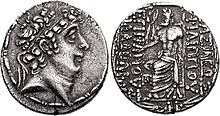| Philip II Philoromaeus | |
|---|---|
| Friend of the Romans | |
 Coin possibly representing Philip II | |
| King of the Seleucid Empire | |
| Reign | 65–64 BC - client king under Pompey, for a time in opposition to Antiochus XIII Asiaticus |
| Predecessor | Antiochus XIII Asiaticus |
| Born | Unknown |
| Died | Possibly 56 BC |
| Dynasty | Seleucid |
| Father | Philip I Philadelphus |
Philip II Philoromaeus (Ancient Greek: Φίλιππος ὁ Φιλορωμαῖος, "Friend of the Romans") or Barypous (Βαρύπους, "Heavy-foot"), a ruler of the Hellenistic Seleucid Empire, was the son of the Seleucid king Philip I Philadelphus, and the last Seleucid king.
Biography
[edit]Philip II himself briefly ruled parts of Syria in the 60s BC, as a client king under Pompey. He competed with his second cousin Antiochus XIII Asiaticus for the favours of the great Roman general, but Pompey would have none of them and had Antiochus murdered. No coins of Philip II are known, which is unusual for Seleucid rulers (the ephemeral Seleucus V Philometor is the only other king for whom this is the case). This may indicate that Philip did not rule in any of the mint cities.
Philip may have survived his deposition: a Seleucid prince Philip is mentioned as a prospective bridegroom to queen Berenice IV of Egypt, sister of Cleopatra VII in 56 BC. The union was, however, checked by the Roman governor of Syria Aulus Gabinius who probably had Philip II killed.
Philip himself was indeed an insignificant pawn, but with him ended eleven generations of Seleucid kings, arguably some of the most influential rulers of the Hellenistic world.
See also
[edit]References
[edit]Citations
[edit]Sources
[edit]- MacKay, Theodora Stillwell (1968). Olba in Rough Cilicia. Bryn Mawr College. p. 91. OCLC 14582261.
- Durukan, Murat (2009). "The Connection of Eastern and Central Cilicia with Piracy". Adalya: The Annual of the Suna & İnan Kıraç Research Institute on Mediterranean Civilizations. 12. Suna & İnan Kıraç Research Institute on Mediterranean Civilizations. ISSN 1301-2746.
- Ehling, Kay (2008). Untersuchungen Zur Geschichte Der Späten Seleukiden (164-63 v. Chr.) Vom Tode Antiochos IV. Bis Zur Einrichtung Der Provinz Syria Unter Pompeius. Historia – Einzelschriften (in German). Vol. 196. Franz Steiner Verlag. ISBN 978-3-515-09035-3. ISSN 0071-7665.
- Tempesta, Claudia (2013). "Central and Local Powers in Hellenistic Rough Cilicia". In Hoff, Michael C.; Townsend, Rhys F. (eds.). Rough Cilicia: New Historical and Archaeological Approaches. Proceedings of an International Conference Held at Lincoln, Nebraska, October 2007. Oxbow Books. p. 40. ISBN 978-1-842-17518-7.
- Tatum, W. Jeffrey (1999). The Patrician Tribune: Publius Clodius Pulcher. Studies in the History of Greece and Rome. University of North Carolina Press. ISBN 978-1-469-62065-7.
- Ach, Kai Tramped (2001). "Tempel und Grossmacht: Olba in Hellenistischer Zeit". In Jean, Eric; Dinçol, Ali M.; Durugönül, Serra (eds.). La Cilicie: Espaces et Pouvoirs Locaux (2e millénaire av. J.-C. – 4e siècle ap. J.-C.). Actes de la Table Ronde d'Istanbul, 2-5 Novembre 1999. Varia Anatolica (in German). Vol. 13. Cambridge University Press. p. 274. ISBN 978-2-906-05364-9.
- Keil, Josef; Wilhelm, Adolf (1931). Denkmäler aus dem Rauhen Kilikien. Monumenta Asiae Minoris Antiqua (in German). Vol. III. Manchester: The University Press. p. 64. OCLC 769301925.
- Vérilhac, Anne-Marie; Dagron, Gérard (1974). "Une Nouvelle Inscription du Temple de Zeus à Diocésarée Uzuncaburç (Cilicie)". Revue des Études Anciennes (in French). 76 (3/4). Presses Universitaires de Bordeaux. ISSN 0035-2004.
- Dobláš, Josef (1924). "Φίλιππος Βαρύπους. Příspěvek к Dějinám Posledních Seleukovců". Listy Filologické/Folia Philologica (in Czech). 51 (4/5). Centre for Classical Studies at the Institute of Philosophy of the Czech Academy of Sciences. ISSN 0024-4457. JSTOR 23454237.
External links
[edit]- Livius entry by Jona Lendering [dead link]
Well, that’s interesting to know that Psilotum nudum are known as whisk ferns. Psilotum nudum is the commoner species of the two. While the P. flaccidum is a rare species and is found in the tropical islands. Both the species are usually epiphytic in habit and grow upon tree ferns. These species may also be terrestrial and grow in humus or in the crevices of the rocks.
View the detailed Guide of Psilotum nudum: Detailed Study Of Psilotum Nudum (Whisk Fern), Classification, Anatomy, Reproduction